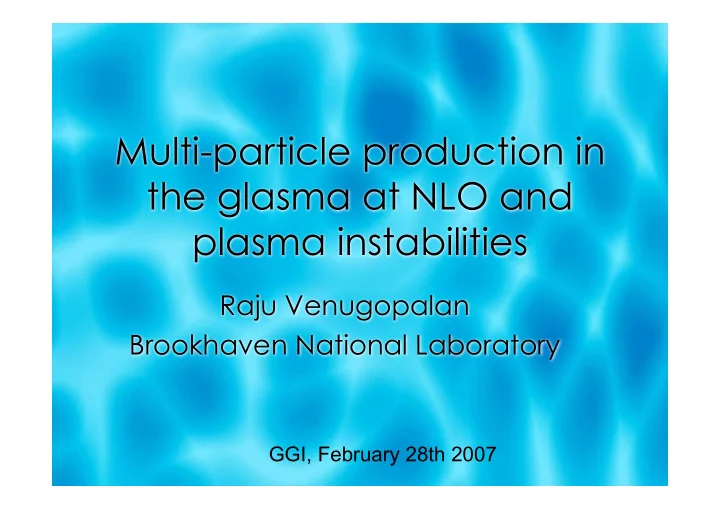

Multi-particle production in the glasma at NLO and plasma instabilities Raju Venugopalan Brookhaven National Laboratory GGI, February 28th 2007
Talk based on: I) Multiparticle production to NLO: F. Gelis & R. Venugopalan, Nucl. Phys. A776, 135 (2006); Nucl. Phys. A779, 177 (2006). II) Plasma Instabilities: P. Romatschke & R. Venugopalan, PRL 96: 062302 (2006); PRD 74:045011 (2006). Recent lectures: F. Gelis and R. Venugopalan, hep-ph/0611157 Theme: deep connection between I) & II) in relation to thermalization of CGC -> QGP
Can we compute multiparticle production ab initio in heavy ion collisions ? Framework: CGC- classical fields + strong sources
Glasma ( \Glahs-maa\ ): Noun: non-equilibrium phase between CGC & QGP T.Lappi & L. McLerran; Kharzeev, Krasnitz, RV
Probability to produce n >> 1 particles in HI collisions: P_n obtained from cut vacuum graphs in field theories with strong sources. Gelis, RV
Systematic power counting for the average multiplicity I) Leading order: From Cutkosky’s rules, sum of all Feynman tree diagrams ⇒ solution of classical equations of motion with retarded b.c.
Yang-Mills Equations for two nuclei Kovner,McLerran,Weigert Initial conditions from matching eqns. of motion on light cone
Lattice Formulation Krasnitz, RV gauge; per unit rapidity, Hamiltonian in For ``perfect’’ pancake nuclei, boost invariant configurations Solve 2+1- D Hamilton’s equations in real time for space-time evolution of glue in Heavy Ion collisions
Krasnitz,Nara,RV Lappi 2D Bose-Einstein (generic for glassy non-eq. classical systems ?) pert. tail Energy density 20 ~ 40 GeV/fm^3 at 0.3 fm at RHIC
II) Multiplicity at next-to-leading order: O ( g^0 ) Gluon pair production One loop corrections to contribution classical field contribute at same order Remarkably, both terms can be computed by solving eq. of motion for the small fluctuations about the classical background field with retarded b.c. - initial value problem Gelis+RV
Results same order in coupling as quark pair production contribution Gelis,Kajantie,Lappi NLO contributions may be essential to understand thermalization in heavy ion collisions Also discussed in framework of Schwinger mechanism Kharzeev, Levin, Tuchin
In the glasma, the classical, boost invariant E & B fields are purely longitudinal Such anisotropic momentum distributions are very unstable-Weibel instability of E.M. plasmas See Bödeker & Strickland talks Small (quantum/NLO) “rapidity dependent ” fluctuations can grow exponentially and generate longitudinal pressure - may hold key to thermalization
Construct model of initial conditions with fluctuations: i) ii) Method: Generate random transverse configurations: Generate Gaussian random function in \eta This construction explicitly satisfies Gauss’ Law
Compute components of the Energy-Momentum Tensor
Hard Loop prediction: Arnold,Lenaghan,Moore Results from 3+1-D numerical simulations of Glasma exploding into the vacuum: Romatschke, RV Non-Abelian Weibel instability seen for very small rapidity dependent fluctuations
Instability saturates at late times-possible non-Abelian saturation of modes ?
Fluctuations become of order of the background field when Expect Our numerical simulations allowed much smaller values: Hence the large times…
Distribution of unstable modes also similar to kinetic theory Arnold, Lenaghan, Moore, Yaffe Romatschke, Strickland, Rebhan
Romatschke, RV Very rapid growth in max. frequency when modes of transverse magnetic field become large - Lorentz force effect on hard transverse mom. modes ?
Growth in longitudinal pressure… Decrease in transverse pressure… > free streaming but < ideal hydro Same conclusion from Hard Loop study Romatschke-Rebhan
Comments: a) Results very sensitive to spectrum of initial fluctuations- numerical results are for a first guess. Fu kushima, Gelis, McLerran Recent WKB analysis of small fluctuations differs significantly…
Comments: b) Understanding high energy factorization (analogous to proofs of collinear factorization) will be important for full NLO estimate Gelis,Lappi,RV
Summary and Outlook Outlined an algorithm to systematically compute particle production in AA collisions to NLO Pieces of this algorithm already exist: Pair production computation of Gelis, Lappi and Kajantie very similar Likewise, the 3+1-D computation of Romatschke and RV + 3+1-D computations of Lappi
Result should include All leading log small x evolution effects NLO contributions to particle production Very relevant for studies of energy loss, thermalization, topological charge, at early times Relation to kinetic theory formulation at late times - in progress (Gelis, Jeon, RV, in preparation)
EXTRA SLIDES
Growth rate proportional to plasmon mass… ~ 2 * prediction from HTL kinetic theory
Recommend
More recommend